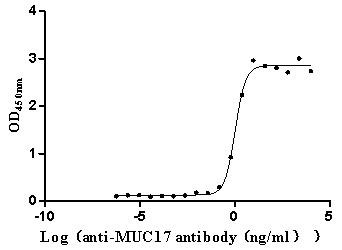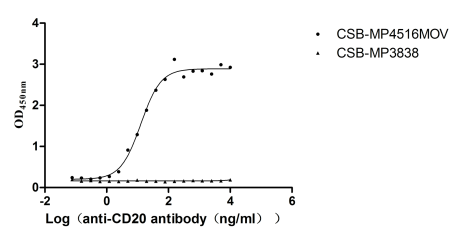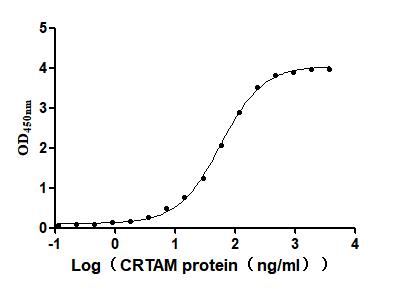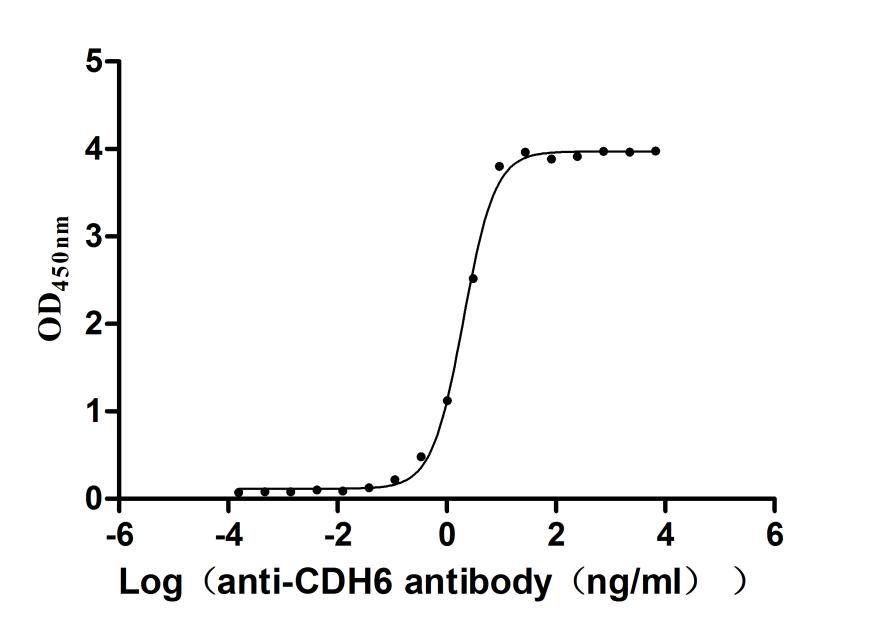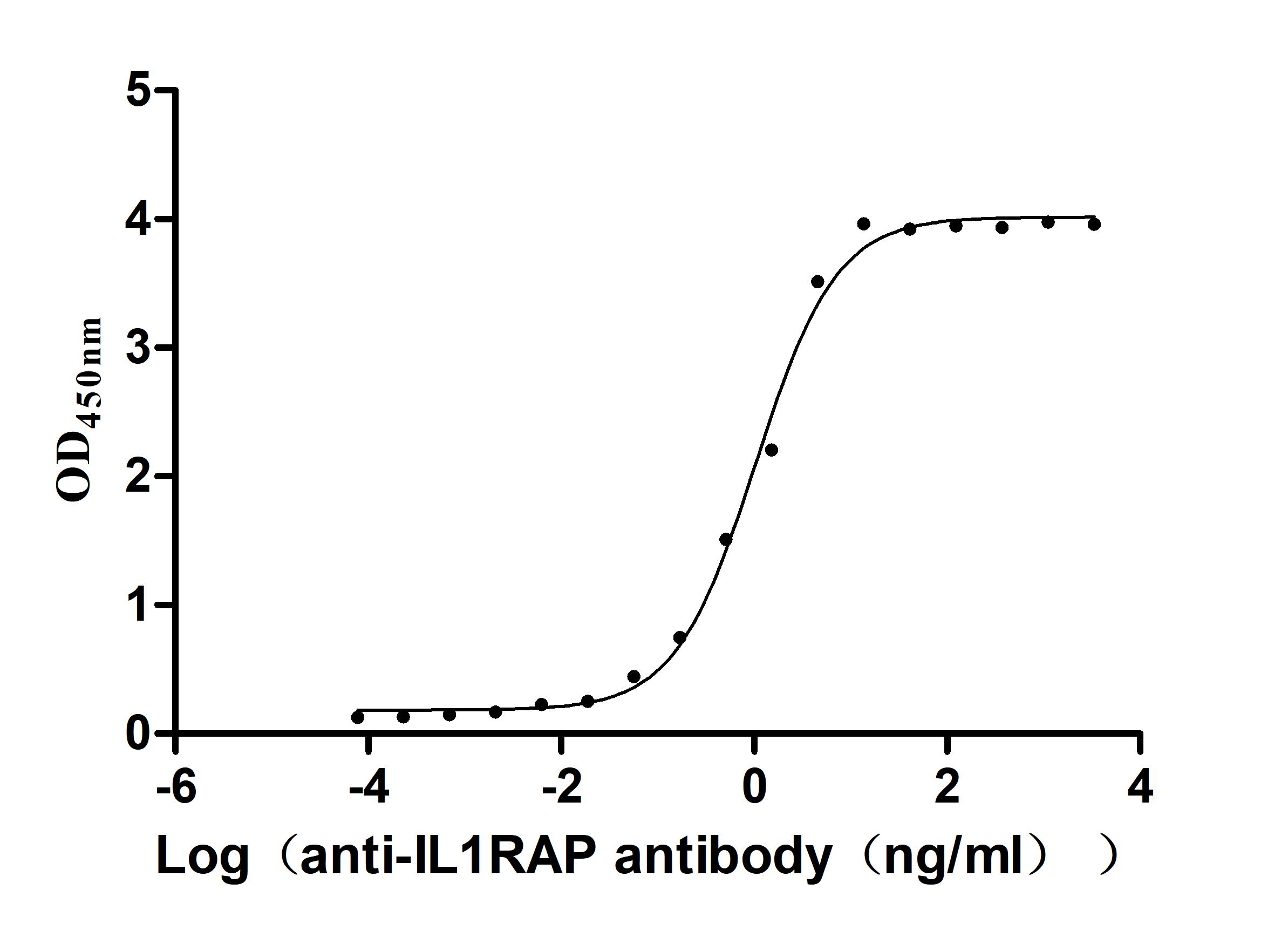Recombinant Human C-X-C motif chemokine 5 (CXCL5), partial
In Stock Promotion-
中文名稱:Recombinant Human C-X-C motif chemokine 5(CXCL5),partial
-
貨號:CSB-EP006250HU1
-
規(guī)格:¥1344
-
促銷:
-
圖片:
-
(Tris-Glycine gel) Discontinuous SDS-PAGE (reduced) with 5% enrichment gel and 15% separation gel.
-
Based on the SEQUEST from database of E.coli host and target protein, the LC-MS/MS Analysis result of CSB-RP061574h could indicate that this peptide derived from E.coli-expressed Homo sapiens (Human) CXCL5.
-
Based on the SEQUEST from database of E.coli host and target protein, the LC-MS/MS Analysis result of CSB-RP061574h could indicate that this peptide derived from E.coli-expressed Homo sapiens (Human) CXCL5.
-
-
其他:
產(chǎn)品詳情
-
純度:Greater than 90% as determined by SDS-PAGE.
-
基因名:
-
Uniprot No.:
-
別名:AMCFII; C-X-C motif chemokine 5; C-X-C motif chemokine ligand 5; Chemokine (C X C motif) ligand 5; chemokine (C-X-C motif) ligand 5; Cxcl5; CXCL5_HUMAN; ENA 78; ENA-78 (8-78); ENA-78(1-78); ENA-78(9-78); ENA78; Epithelial derived neutrophil activating protein 78; Epithelial-derived neutrophil-activating protein 78; Lipopolysaccharide-induced CXC chemokine; Neutrophil activating peptide ENA 78 ; Neutrophil activating protein 78; Neutrophil-activating peptide ENA-78; neutrophil-activating protein 78; SCYB5; Small inducible cytokine B5 ; small inducible cytokine subfamily B (Cys-X-Cys); member 5 (epithelial-derived neutrophil-activating peptide 78); small inducible cytokine subfamily B; member 5; Small-inducible cytokine B5
-
種屬:Homo sapiens (Human)
-
蛋白長度:Partial
-
來源:E.coli
-
分子量:11.9kDa
-
表達區(qū)域:37-110aa
-
氨基酸序列AGPAAAVLRELRCVCLQTTQGVHPKMISNLQVFAIGPQCSKVEVVASLKNGKEICLDPEAPFLKKVIQKILDGG
Note: The complete sequence including tag sequence, target protein sequence and linker sequence could be provided upon request. -
蛋白標簽:N-terminal 6xHis-tagged
-
產(chǎn)品提供形式:Liquid or Lyophilized powder
Note: We will preferentially ship the format that we have in stock, however, if you have any special requirement for the format, please remark your requirement when placing the order, we will prepare according to your demand. -
緩沖液:Tris-based buffer,50% glycerol
-
儲存條件:Store at -20°C/-80°C upon receipt, aliquoting is necessary for mutiple use. Avoid repeated freeze-thaw cycles.
-
保質(zhì)期:The shelf life is related to many factors, storage state, buffer ingredients, storage temperature and the stability of the protein itself.
Generally, the shelf life of liquid form is 6 months at -20°C/-80°C. The shelf life of lyophilized form is 12 months at -20°C/-80°C. -
貨期:3-7 business days
-
注意事項:Repeated freezing and thawing is not recommended. Store working aliquots at 4°C for up to one week.
-
Datasheet & COA:Please contact us to get it.
相關(guān)產(chǎn)品
靶點詳情
-
功能:Involved in neutrophil activation. In vitro, ENA-78(8-78) and ENA-78(9-78) show a threefold higher chemotactic activity for neutrophil granulocytes.
-
基因功能參考文獻:
- Serum CXCL5 levels from pemphigus vulgaris patients are significantly higher than those in bullous pemphigoid patients and healthy controls. PMID: 27501402
- These data demonstrated that CXCL5 expression was upregulated in prostate cancer tissues and that exogenous CXCL5 protein exposure or CXCL5 overexpression promoted malignant phenotypes of prostate cancer cells in vitro and in vivo. PMID: 29749439
- activated CXCL5-CXCR2 axis contributes to the metastatic phenotype of PTC cells by modulating Akt/GSK-3beta/beta-catenin pathway PMID: 29471001
- study elucidates the important role of CXCL5 in the progression and prognosis of NSCLC. These findings suggested that CXCL5 might be a potential biomarker and novel therapeutic target for lung cancer PMID: 29526026
- PERK-p-eIF2alpha pathway could suppress metastasis in triple-negative breast cancer by inhibiting expression of PDL1 and CXCL5 in tumor cells. PMID: 29053414
- Mechanistically, AR modulated cytokine CXCL5 expression by altering AKT --> NF-kappaB signaling, and interruption of AKT --> NF-kappaB --> CXCL5 signaling using either specific inhibitors or siRNA suppressed AR-enhanced EC recruitment and AR-EC-promoted RCC progression. PMID: 27848972
- Curcumin suppressed CXCL5 expression by direct inhibition of IKKbeta phosphorylation, and inhibition of p38 MAPK via induction of negative regulator MKP-1. PMID: 27538525
- The CXCL5 and the overexpression of miR-141 reduced levels of MMP-2 and MMP-9 in tumor necrosis factor-alpha-treated HT29 cells by means of repressing the inhibitory AKT. PMID: 28854064
- CXCL5 may promote mitomycin resistance by activating EMT and NF-kappaB pathway. Thus, this study identifies CXCL5 as a novel chemoresistance-related marker in non-muscle invasive bladder cancer PMID: 29545183
- findings for the first time provided evidence that ENA78 may play a key role of mediator in pathogenesis of Major Depressive Disorder(MDD) and in the mechanism of vinlafaxine effects on MDD. PMID: 28441588
- our findings support CXCL5 as a promoter of colorectal cancer metastasis and a predictor of poor clinical outcomes in colorectal cancer patients. PMID: 28356111
- CXCL5 levels were decreased in LSCC patient serum. PMID: 27876461
- a finely tuned balance between the GAG-bound dimer and free soluble monomer regulates CXCL5-mediated receptor signaling and function. PMID: 27471273
- CXCL5 plays a promoting role in glioma in autocrine- and paracrine-dependent manners. PMID: 27748886
- The expression of CXCL5 is up-regulated in osteosarcoma cells. PMID: 28277189
- CXCL5 expression in urine is related to bladder cancer TNM stage, lymph node metastasis, tumor size, and tumor grade. PMID: 26503215
- ENA 78 plasma levels were correlated with Expanded Disability Status Scale scores in neuromyelitis optica (NMO) patients; elevated secretion of ENA 78 may be a critical step in neutrophil recruitment during the remission of NMO. PMID: 27401736
- CXCL5 expression is enriched in human atherosclerotic coronary artery. The CXCL5 variant might be a genetic risk factor for the susceptibility of CAD and the CXCL5 promoter -156 G/C C allele might be an independent predictor for CAD. PMID: 26287498
- Study shows that CXCL5 expression is elevated in positive correlation to bladder cancer grade and promotes cell migration and invasion via binding to its receptor CXCR2. PMID: 26058729
- Analysis of monocultured dermal fibroblasts and keratinocytes revealed that only fibroblasts but not keratinocytes displayed up regulated CXCL5 levels after UV stimulation. PMID: 25690483
- There was an inverse correlation between DACH1 mRNA levels and CXCL5 in both lung cancer cell lines and human NSCLC tissues. PMID: 25788272
- High CXCL5 expression is associated with pediatric ulcerative colitis. PMID: 25738378
- the increased level of CXCL5 in tissue compartments, including the central nervous system of HIV-1-infected individuals might alter the inflammatory response through the infiltration of neutrophils into tissue compartment PMID: 25536401
- Serum levels of ENA-78 were elevated in autistic children and they were significantly associated with the increased levels of serum antineuronal auto-antibodies PMID: 25871636
- This study aims to evaluate serum levels of ENA78/CXCL5 and SDF-1/CXCL12 along the gastric cancer carcinogenesis, and analyze their clinical significance, and diagnostic potentials through human serum samples. PMID: 25689618
- our data showed that the CXCR2/CXCL5 axis contributes to EMT of HCC cells through activating PI3K/Akt/GSK-3beta/Snail signaling, and it may serve as a potential therapeutic target. PMID: 25462858
- Solution structure of CXCL5--a novel chemokine and adipokine implicated in inflammation and obesity PMID: 24695525
- the expression levels of CXCL5 proteins were decreased in dermal blood vessels of early stage diffuse cutaneous systemic sclerosis PMID: 24292093
- data indicates that LCCs per se may act as the producer and receptor of CXCL5 responsible for liver cancer migration and invasion PMID: 25011526
- Citrullinated ENA-78/CXCL5 is highly correlated with rheumatoid arthritis disease activity and, unlike noncitrullinated ENA-78/CXCL5, recruits monocytes. PMID: 24943990
- CXCL5 showed a statistically significant prognostic effect PMID: 24500664
- mRNA and protein of CXCL5 is increased in bladder tumor tissues and cell lines; down-regulation of CXCL5 resulted in significantly decreased cell proliferation, migration and increased cell apoptosis through Snail, PI3K-AKT and ERK1/2 signaling pathways. PMID: 24583128
- Knockdown of HSP27 by shRNA decreased HB-EGF plus CXCL5-mediated tumor spheroid formation in a three-dimensional culture system, suggesting that AKT/HSP27 was required for HB-EGF/CXCL5-mediated cancer progression PMID: 24346967
- Liver cancer cells with high metastatic potential have a higher expression of CXCL5. Exogenous CXCL5 can increase the proliferation, migration and invasion of liver cancer cells with low metastatic potential. PMID: 23290114
- sCXCL5 level was determined to be an independent prognostic factor for NPC patients PMID: 23469080
- Increased levels of CXCL5 contribute to enhanced levels of RANKL expression in Paget's disease of bone. PMID: 23439434
- CXCL5 gene polymorphisms are functional and associated with variable blood pressure in cardiovascular disease-free individuals. PMID: 23245743
- CXCL5 promotes HCC cell proliferation, invasion, and intratumoral neutrophil infiltration. PMID: 22711685
- Preoperative serum CXCL5 could serve as a novel predictive marker for prognosis determination of colorectal cancer patients. PMID: 22197219
- Endothelial production of both ENA-78 and IL-8 was induced by the proinflammatory cytokine IL-1beta. PMID: 22274300
- Serum CXC ligand 5 is a new marker of subclinical atherosclerosis in type 2 diabetes. PMID: 21609350
- Blockade of CXCL5 can modulate IL-17-induced arthritic inflammation in part by reducing joint blood vessel formation through a non-overlapping IL-17 mechanism. PMID: 21779896
- Data demonstrate that the chemokine CXCL5 is a peripheral mediator of UVB-induced inflammatory pain, likely in humans as well as rats. PMID: 21734176
- Plasma CXCL5 levels are lower in patients with chronic liver disease, suggesting that CXCL5 might be involved in the pathogenesis of chronic liver disease. PMID: 21332547
- CXCL5/ENA78 increased cell migration and epithelial-to-mesenchymal transition of hormone-independent prostate cancer by early growth response-1/snail signaling pathway. PMID: 20945384
- Report influence of troglitazone, sodium butyrate, 5-aminosalicylic acid and BAY 11-7082 on the chemokine ENA-78/CXCL5 secretion in the intestinal subepithelial myofibroblasts. PMID: 21229889
- CD14 and CXCL5 were both expressed in tunica intima and tunica adventitia of adipose tissue blood vessels; CXCL5 exhibited chemoattractant and angiogenic properties. PMID: 21034724
- The highly divergent effects of modifications of CXCL5 on neutrophil influx underline the potential importance of tissue-specific interactions between chemokines and PAD or proteases. PMID: 20630876
- expression in gingival epithelial cells is induced by thrombin via activation of protease-activated receptor 1 PMID: 19567485
- Elevated circulating CXCL5 concentrations were associated with higher risk of hypercholesterolemia in middle-aged and elderly Chinese independent of obesity, inflammation, adipokines, and other risk factors but not insulin resistance. PMID: 20501684
顯示更多
收起更多
-
亞細胞定位:Secreted.
-
蛋白家族:Intercrine alpha (chemokine CxC) family
-
數(shù)據(jù)庫鏈接:
Most popular with customers
-
Recombinant Human Tumor necrosis factor ligand superfamily member 8 (TNFSF8), partial (Active)
Express system: Mammalian cell
Species: Homo sapiens (Human)
-
Recombinant Human Claudin-18.2 (CLDN18.2)-VLPs (Active)
Express system: Mammalian cell
Species: Homo sapiens (Human)
-
Recombinant Human Mucin-17 (MUC17), partial (Active)
Express system: Mammalian cell
Species: Homo sapiens (Human)
-
Recombinant Macaca fascicularis Membrane spanning 4-domains A1 (MS4A1)-VLPs (Active)
Express system: Mammalian cell
Species: Macaca fascicularis (Crab-eating macaque) (Cynomolgus monkey)
-
Recombinant Mouse Cytotoxic and regulatory T-cell molecule (Crtam), partial (Active)
Express system: Mammalian cell
Species: Mus musculus (Mouse)
-
Recombinant Human C-C chemokine receptor type 6(CCR6)-VLPs (Active)
Express system: Mammalian cell
Species: Homo sapiens (Human)
-
Recombinant Mouse Cadherin-6(Cdh6),partial (Active)
Express system: Mammalian cell
Species: Mus musculus (Mouse)
-
Recombinant Macaca fascicularis Interleukin 1 receptor accessory protein(IL1RAP), partial (Active)
Express system: Mammalian cell
Species: Macaca fascicularis (Crab-eating macaque) (Cynomolgus monkey)







-AC1.jpg)
